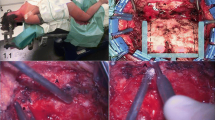Abstract
There is no effective alternative to surgery in the treatment of the symptomatic cases of chiari malformation. Nonetheless, in literature there is no unanimous consensus about what is the surgical “gold standard” and which are the candidates for surgery. No doubt that intracranial hypertension and ventricular dilatation have to be investigated and treated before considering decompression. It is also very important to keep in mind that a surgery does not guarantee a complete recovery from every symptoms. We report our experience about who are the candidates for surgery, which is the most appropriate surgical technique and when is the correct time for surgery along the natural history of the disease.

Similar content being viewed by others
References
Bogdanov EI, Mendelevich EG (2002) Syrinx size and duration of symptoms predict the pace progressive mielopathy: retrospective analysis of 103 unoperated cases with craniocervical junction malformations and syringomyelia. Clin Neurol Neurosurg 104:90–97
Durham SR, Fjeld-Olenec K (2008) Comparison of posterior fossa decompression with and without duroplasty for the surgical treatment of Chiari malformation Type I in pediatric patients: a meta-anallysis. J Neurosurg Pediatr 2:42–49
Dyste GN, Menezes AH, VanGilder JC (1989) Symptomatic Chiari malformation. An analysis of presentation, management and long-term outcome. J Neurosurg 71:159–168
Elton S, Tubbs RS, Wellons JC 3rd, Blount JP, Grabb PA, Oakes WJ (2002) Acute hydrocephalus following a Chiari I decompression. Pediatr Neurosurg 36:101–104
Greenlee JD, Donovan KA, Hasan DM, Menezes AH (2002) Chiari I malformation in very young child: the spectrum of presentations and experience in 31 children under age 6 years. Pediatrics 110(6):1212–1219
Listernick R, Tomita T (1991) Persistent crying in infancy as a presentation of Chiari type 1 malformation. J Pediatr 118:567–569
Milhorat TH, Chou MW, Trinidad EM, Kula RW, Mandell M, Wolpert C, Speer MC (1999) CMI redefined: clinical and radiographic findings for 364 symptomatic patients. Neurosurg 44:1005–1017
Nohira V, Oakes WJ (1990) Chiari I Malformation: a review of 43 patients. Pediatr Neurosurg 16:222–227
Oakes WJ, Worley G, Spock A (1988) Surgical intervention in twenty-nine patients with symptomatic type II Chiari malformations: clinical presentation and outcome. Concepts Pediatr Neurosurg 8:76–85
Oakes WJ, Gaskill SJ (1992) Symptomatic Chiari malformation and syringohydromyelia in childhood. In: Park TS Spinal dysraphism. Blackwell Boston, pp 104–105
Pollack IF, Kinnunen D, Albright AL (1996) The effect of early craniocervical decompression on functional outcome in neonates and and young children with myelodysplasia and symptomatic Chiari II malformation: results from a prospective series. Neurosurg 38:703–710
Salomao JF, Bellas AR, Leibinger RD, Barbosa AP, Brandao MA (1998) Symptomatic Chiari type II malformation. Arq Neuropsiquiatr 56:98–106
Conflict of interest
The authors declare that there is no actual or potential conflict of interest in relation to this article.
Author information
Authors and Affiliations
Corresponding author
Rights and permissions
About this article
Cite this article
Imperato, A., Seneca, V., Cioffi, V. et al. Treatment of Chiari malformation: who, when and how. Neurol Sci 32 (Suppl 3), 335–339 (2011). https://doi.org/10.1007/s10072-011-0709-y
Published:
Issue Date:
DOI: https://doi.org/10.1007/s10072-011-0709-y




